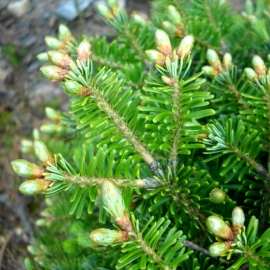


Organic Silver Fir Seeds (Abies Alba)
1.14 €
The European Silver Fir is one of the tallest growing conifers in Europe with a maximum height of 67m (220ft). It is native to the mountains of Europe stretching from the Pyrenees and eastwards to the Alps and the Carpathians, Slovenia and Croatia.
-
Organic Silver Fir (Abies Alba)
The European Silver Fir is one of the tallest growing conifers in Europe with a maximum height of 67m (220ft). It is native to the mountains of Europe stretching from the Pyrenees and eastwards to the Alps and the Carpathians, Slovenia, Croatia, Bosnia and Herzegovina and south to southern Italy and northern Serbia.
It is fast growing and frost hardy and suitable for growing on a wide range of soils except those that have an alkaline pH. It prefers moist soil and is quite happy growing in heavy clay. It grows to its best development when planted in an open, sunny position but it can also grow reasonably in semi-shade and will even struggle on slowly growing in deep shade in thick forests, waiting for an opening in the canopy to allow in enough light for good growth.
It cannot tolerate atmospheric pollution or wind exposure and is best planted in sheltered positions on north facing slopes. This species is notably resistant to honey fungus. Like most of the true fir species growth is slow for the first few years from germination but from the age of around 4 years growth soon accelerates and height increases of 1 meter or more per year is possible on favoured sites.
It is also commonly used for the production of Christmas trees because of its attractive flattened needles that are glossy dark green above with two greenish-white bands on the underside that give the tree an attractive silvery sheen. The needles also give of a beautiful vibrant aroma when they crushed.
How to Grow
Seeds of the true fir species are relatively easy to germinate and grow. The dormancy within the seed is short and easily broken. This is achieved by a short period of cold stratification in the fridge.
You can do this by first soaking the seeds in water for 24 hours. Fully drain away all of the water and place the seeds in a zip-lock freezer bag. Place the seeds in the fridge, it is important that during this period that the seeds do not dry out or are waterlogged otherwise the pre-treatment will be ineffective. After between 6 and 8 weeks under these conditions the seeds are ready to be sown. In general, the seeds will fail to germinate unless treated in this way, simply sowing untreated seeds in compost at room temperature will not break down the dormancy and germination will be disappointing.
Fill your chosen container with a good quality general potting compost. Suitable containers could be plant pots, seed trays or plug trays or even improvised containers with drainage holes. Firm the compost gently and sow the seeds on the surface. If you are sowing in plug trays, sow 2 or 3 seeds per cell. Cover the seeds with a couple of millimeters of vermiculite or failing that a fine layer of sieved compost. Follow with a gentle watering and keep them at room temperature.
Germination will begin a few weeks from sowing. The seedlings are reasonably robust and trouble free and usually grow to a height of between 2 and 5 cm in the first growing season depending on the sowing date and cultural techniques. Densely sown seedlings are at risk from fungal diseases such as “damping off” which can cause rapid loss of many seedlings.
Developing seedlings should be fine in full sun, keep them well watered and free of competing weeds. Growth will accelerate in the second and subsequent years and the developing young trees should be re-potted as necessary preferably during the dormant season. After perhaps 3 years they are ready to be planted in their permanent position
